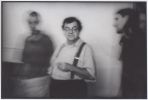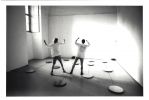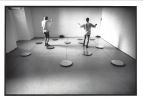"After having toured with Phill Niblock, where I made five installations and seven concerts in Krakow, Wroclaw, Lodz and Warsaw, my visit to the Plasy monastery meant the finale of a one-month trip. I didn’t know much about the space where I was expected to present my work, neither about the social and cultural context in which the event would take place.
Jana and Miloš told me immediately after my arrival about a wonderful freshly renovated chapel in the convent, which they expected to be perfect for my installation. They showed me the space, and I agreed with them that St. Bernard's chapel is a wonderful sound chamber with very lively acoustics, echoing and reverberating, and sounding warm and beautiful. It also has a very beautifully shaped Baroque interior.
This made me decide to make an almost immaterial installation. I only stretched five piano-strings from the hinges of the open doors to the hinges of the windows. The strings were stretched with turnbuckles. The distances between the door and the windows tuned the strings. I didn't use amplification, no P. A. and no acoustical resonators. I decided to have no audience in the room, since the presence of people in a space mostly changes the acoustical qualities. The chapel was to become the instrument itself with the musicians inside. The doors were the sound-hole through which the music left the instrument into the corridor where the audience was. I invited Phill Niblock to play two of the strings. I played the three other strings myself. I invited Jo Truman, since I like her voice and the sounds of her didgeridoo and I wondered how these would sound in this space. I invited Michael Delia after I had heard his drum and kalimba in the space. All the sounds melted together in the chapel. This was a remarkable experience."
Paul Panhuysen, Plasy 1992
This is an account of the production of Dutch composer and visual/sound artist Paul Panhuysen’s ‘long string’ installations, which crossed a range of spaces in various ways and were, in fact, sound sculptures that could be played. Over a period of 30 years, Panhuysen made more than 250 long string installations in many locations around the world, drawing attention to the perception of our environment and the ways in which its parameters are detected, transformed and analysed by our senses, simultaneously engaging both seeing and hearing.
Tuned just in intonation, the long string instrument is played by walking along the length of long strings, attached to the doors and windows and rubbing them with resined hands. This produces longitudinal vibrations, and the musician explores the nodes of vibration. Paul Panhuysen developed with Johan Goedheart many pieces which were notated with choreography.
Long String concert in the st. Bernard chapel, together with Phill Niblock, Michael Delia, Jo Truman was recorded by Avik. The concert took place on June 20th, 1992.
Paul Panhyusen (born 1934 in Borgharen, Netherlands, died 2015) was a Dutch composer, visual and sound artist and curator. He founded and directed Het Apollohuis, an art space that functioned during the 80's and 90's which had artists doing sound installations, sound sculptures, and concerts about free improvisation, experimental music, and electronic music.
Paul was one of the godfathers of the Hermit Foundation, who directly inspired Miloš Vojtěchovský to get engaged in the project of Plasy. Paul and his wife Helén Panhuysen advised, provided contacts and recommended to Vojtěchovský artists to invite. Miloš Vojtěchovský visited Het Apollohuis in Eindhoven probably in 1986, via two American musicians David Drum and Ann LaBerge, who live in Amsterdam. Het Apollohuis has featured exhibitions of Czech and Slovak experimental and conceptual art (Karel Adamus, Dalibor Chatrný, Jiří Valoch, etc. in ca. 1991), and concerts (Iva Bittová, Pavel Fajt, Marian Palla, Petr Kotík, Jiří Valoch, etc). Paul recieved an award and held an exhibtion in Klenová gallery in 1998, performed at the National Gallery in the framework of The Dawn of the Magicians project (1997) and participated in the program of Maraton nové hudby in the Archa Theater.
Paul Panhuysen studied art at the Jan van Eyck Academie in Maastricht from 1954 to 1959. He then turned to the study of the sociology of art at the University of Utrecht, which he studied until 1961. In Leeuwarden, he was director of the Kunstgewerbeschule, and worked as curator in Den Haag and Eindhoven. Influenced by Situationism, he then advanced to become the leading member of the second generation of the Dutch Fluxus movement. Beginning with painting, he then extended his repertoire throughout the 1960s into the fields of media, urban planning and music, going on to found artists’ associations, and to become a member of numerous committees on museum education. Furthermore, with hundreds of performances behind him, he was one of the protagonists of time-based arts working, with the Maciunas Ensemble. He was also intensively occupied with generatively created music. In collaboration with his wife Hélène and Remco Scha, he founded the artists’ platform Het Apollohuis in Eindhoven, in 1980. The platform (gallery, studios, publishing house) closed in 2001, and the archive is currently housed and managed by the ZKM.









